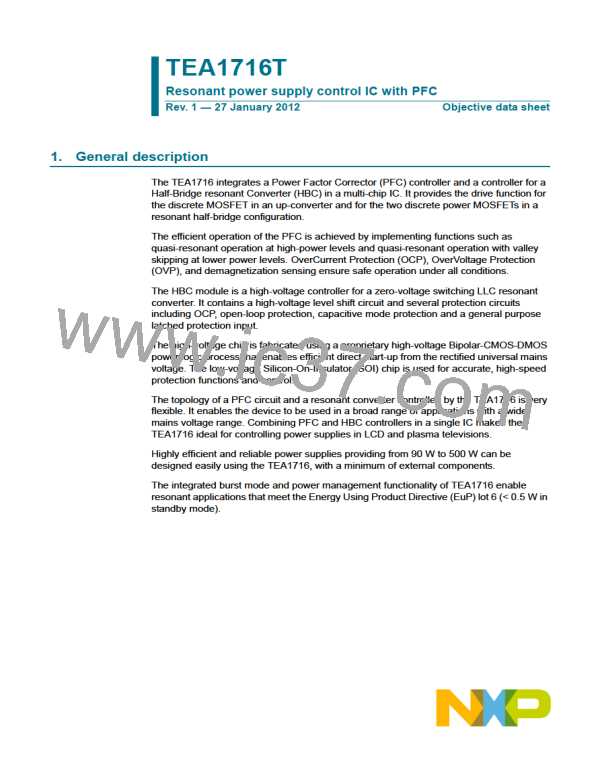TEA1716T
NXP Semiconductors
Resonant power supply control IC with PFC
I
ocr
I
Cur(HBC)
−I
0
t
t
ocr
I
ss(hf)(SSHBC)
I
ss(If)(SSHBC)
ss(If)(SSHBC)
I
SSHBC/EN
−I
−I
ss(hf)(SSHBC)
V
fmin(SSHBC)
V
SSHBC/EN
V
ss(hf-lf)(SSHBC)
V
fmax(SSHBC)
0
t
V
reg
V
Output
t
Slow soft-start sweep (charge and discharge)
014aaa866
0
Fast soft-start sweep (charge and discharge)
Fig 16. Overcurrent regulation during start-up
The protection timer is also started. The Restart state is activated when the OCR-HBC
condition is still present after the protection time has elapsed.
7.8.10.3 Overcurrent protection, OCP-HBC
Under normal operating conditions, OCR is able to ensure the current remains below the
specified maximum values. If certain error conditions occur, however, it is probably not
fast enough to limit the current. OCP is implemented to protect against those error
conditions. The OCP level, Vocp(HBC) (1.75 V and +1.75 V typical), is higher than the
OCR level Vocr(HBC)
.
When the OCP level is reached, the frequency immediately jumps to the maximum value
via the soft start reset, followed by a normal sweep down.
7.8.11 HBC capacitive mode regulation, CMR (pin HB)
The MOSFETs in the half-bridge drive the resonant circuit. Depending on the output load,
the output voltage, and the switching frequency this resonant circuit can have an inductive
impedance or a capacitive impedance. Inductive impedance is preferred because it
facilitates efficient zero-voltage switching.
The adaptive non-overlap time function (see Section 7.8.4.2) prevents harmful switching
in Capacitive mode. An extra action is performed which results in Capacitive Mode
Regulation (CMR). CMR causes the half-bridge circuit to return to Inductive mode from
Capacitive mode.
TEA1716T
All information provided in this document is subject to legal disclaimers.
© NXP B.V. 2012. All rights reserved.
Objective data sheet
Rev. 1 — 27 January 2012
30 of 46

 ETC [ ETC ]
ETC [ ETC ]